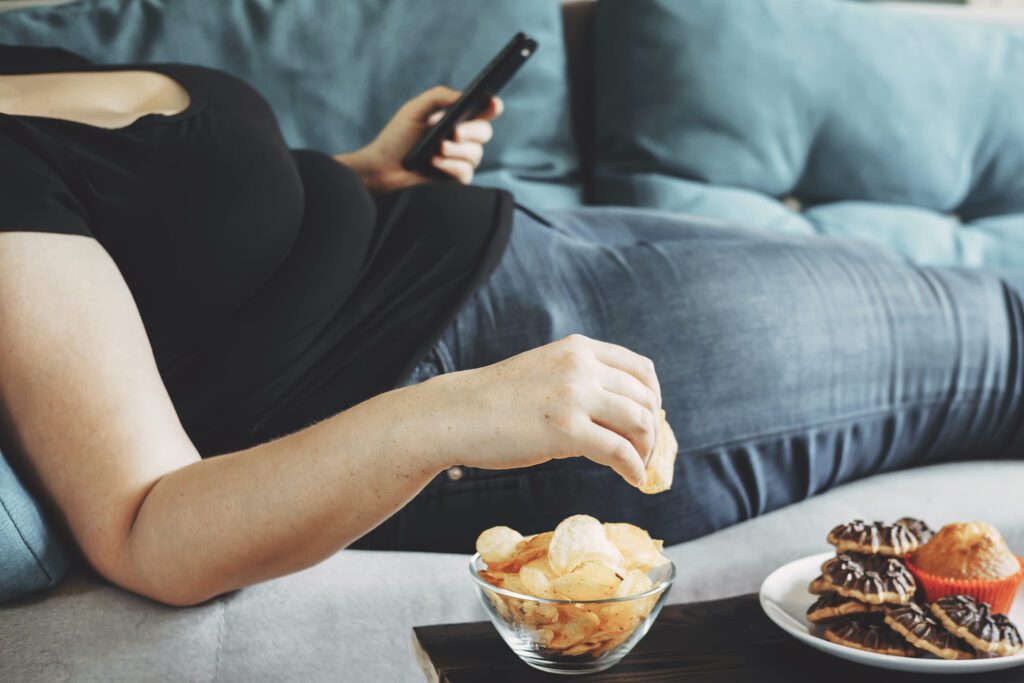Thinking of food while in an emotional state is common for many people. Food is one of the first experiences we have of love and connection with a parent. Getting fed by our parents: that deep sense of comfort, fulfillment, and satisfaction we experience as children, stays with us for a lifetime.
“Eat to fuel your body, not to feed your emotions.”
unknown
Modern society is also strongly geared to thinking of food as a source of entertainment, socialization, and comfort, and few make it through life without associating food in this way. For some of us, however, this can be taken to a negative level, called emotional eating, creating genuine problems that may need to be addressed.
⦿ What’s the difference between emotional eating and regular eating?
Emotional eating can occur suddenly and intensely. One usually craves for very specific foods, like pizza, ice cream, or chocolate. Eating does not lead to a feeling of being full and is often followed by experiences of deep guilt and shame. This usually leads to dieting and deprivation which can lead to emotional eating again. It can be a painful cycle to live in, especially when it starts impacting your health.

We emotionally eat in attempt to numb ourselves, provide a feeling of escape, or to change or amplify our feelings. Each person has different root causes. Understanding the underlying root cause of your specific type of emotional eating is essential to finding balance again.
Stress
Cortisol is a hormone we release in the morning that gives us motivation and the impulse to get moving into our day. It is also the hormone that is released when we are alarmed, stressed, or upset. Elevated cortisol can make you crave sugary, fatty, and salty foods. Our bodies are hardwired this way from when being in fight or flight meant needing extra calories for action. Today, this means craving and holding onto calories in the body whenever we experience this stress response.
Food and Feelings
Based on our biological reaction to stress, it’s no wonder emotional eating is such a common pain we face today. Furthermore, society frowns on unpleasant emotional expression. Anger, anxiety, sadness, panic, boredom, emptiness, loneliness, and shame are all usually unwelcome feelings to express. We’re taught to bury them and keep them hidden. This is where food comes in to numb us, distract us, and remove our emotional pain.
Coping Mechanism
Emotional eating is a very common coping mechanism for getting rid of anything we don’t want to feel.
This could include:
- Loneliness and feelings of emptiness
- Sadness, vulnerability, shame, and anger
- Feelings of helplessness
- Need for comfort, safety, and love
- Boredom
- Tiredness
- Excess energy, stress, fear, or anxiety
⦿ How do we shift this?
- Firstly, stop the dieting.
Deprivation techniques not only do not work, but they can also lead to heavier episodes of emotional eating. They increase stress and may lead to increased inner criticism, which increases shame and the overeating cycle.
- Get to the root of the emotional issue.
Seeing a therapist can help you face your feelings. When you get the impulse to emotionally eat, ask yourself what feelings you are trying to avoid. Journal everything you feel.
- Find new ways to self-soothe.
- Meditation
- Deep breathing exercises
- Having a cup of warm herbal tea
- Going for a short walk to regulate and process feelings and shift your state
- Periodic breaks of lying down for 10 to 20 minutes
- Have healthy snacks on hand.
Having healthy snacks on hand like fruit and herbal teas can help manage the cravings.
- Gentle exercise
Walking, yoga, swimming, and stretching can all help to regulate feelings and put us back on track when we are undergoing stress. Emotional eating takes us out of our bodies to a numb place where we are in a state of compulsion. Gentle exercise lowers cortisol, resets and regulates our body chemistry and feelings. Taking 10 minutes to get physical and tune in to the self when the emotional eating cravings set in, can help to process what it is that we may really feel and need instead.
At the end, it’s important to be loving, caring, and gentle with oneself to reduce emotional eating signals.






